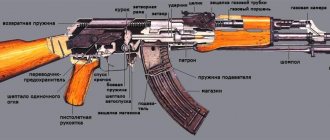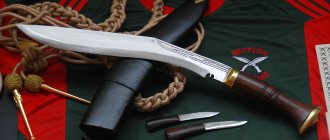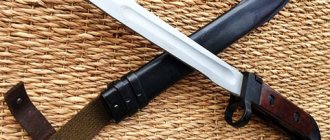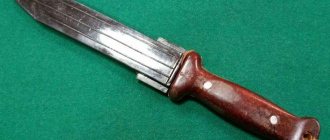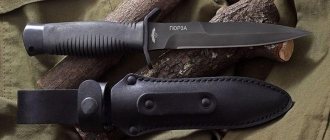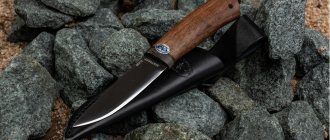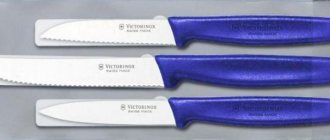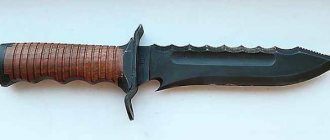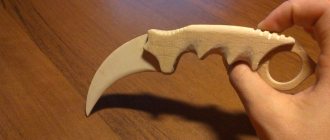A knife is a great invention of mankind, be it a kitchen, hunting, folding or tourist blade. Behind the laconic appearance lies a complex design that ensures ease of cutting and ease of use. The main elements, undoubtedly, are the sharpened blade and the handle, but additional parts of the knife, whose names are the guard, butt, bolster and others, are necessary for correct geometry, balancing and protection from injury. Let's look at the structure of a knife from a professional's point of view.
History of the knife
The very first knives appeared in the Paleolithic era. Most often these were flint or obsidian pieces of stone. Which were chipped until a cutting edge was formed. And then man came up with the idea of attaching wooden or bone handles to them.
Knives were also made from pieces of bones, shells or hard wood. Products began to be made from copper and bronze about 5 thousand years ago. When metals were discovered for processing. And in South America, knives were even made from gold.
The beginning of the Iron Age is marked by the displacement of bronze and copper products. And with the beginning of the industrial revolution, I began to produce knives on a factory scale, and they put this business on stream. Over time, the design and materials of knives change.
High technology and availability of products is becoming the main breakthrough in production. Folding knives appear. Blades are beginning to be produced in all countries of the world.
Materials for production
In order for the product to last a long time, it is necessary to correctly select the materials used in the manufacture of the knives from which it will be created.
Initially, knives were made from fragments of edged weapons: spears, sabers, checkers, daggers made of iron. Over time, the composition changed, but the main conditions remained strength and reliability.
For their manufacture, various types of steel and alloys are used, which are characterized by wear resistance, high corrosion resistance, and blade strength. At the same time, its strength must be such that the knife can be sharpened quickly and easily, and it acquires the necessary sharpness.
Components of a knife
Product from Chrysostom.
The main parts of a knife are the blade and the handle. These parts cannot exist separately; they complement each other and interact in the logic of functionality and purpose.
A good knife has a durable and flexible blade. But it must also be wear-resistant and resist corrosion well.
The secrets of the masters are hidden in these simple characteristics of the blades. Knowledge accumulated over the years is sometimes protected from prying eyes. In modern Russia, the production of knives received a good boost after the crisis in 1998.
Then all kinds of small private enterprises and metalworking handicraft industries began to appear. But then they became very popular among the people. Cities such as Zlatoust, Vorsma, Pavlov became traditional centers for the production of knives.
Deep knowledge of the laws of metalworking and the properties of steel allowed blade craftsmen to raise the bar for metal processing to the proper level. Masters became recognizable by their individual designs and blade designs.
Anatomy of a knife
Among knifemakers there is their own terminology for parts of products. There are various patterns and names that even knife enthusiasts should know. Let's look at the structure of a knife in more detail and find out how its parts are correctly called:
- The strip is the shank together with the blade, no matter what type of installation.
- Blade length is the length measured from the tip to the point where the handle begins.
- The blade is one of the main parts of the knife that makes the cut. Here we mean the entire visible part of the strip, excluding the part that is under the handle.
- The shank is the part of the strip that is hidden in the handle.
- The butt is the unsharpened edge of the blade that is located on top. May have a longitudinal rib for crushing various products.
- The thumb rest is located on the butt of the blade near the handle. Often it has a notch for convenience so that your finger does not slip off.
- The bevel of the butt is the line of transition of the butt to the tip. In European versions, the bevel is mostly straight or slightly concave.
- A sharpened butt bevel is an additional cutting edge that is formed by two narrow slopes on the butt bevel. This increases the effectiveness of piercing blows, the blade becomes like a dagger.
- A false blade is a part of the butt formed by two narrow slopes; in some cases it is sharpened.
- Golomen is the flat side surface of the blade from the butt to the beginning of the descent line.
- Dol - its incorrect name is blood flow. It reduces the weight of the blade and serves as a longitudinal stiffening rib.
- Toe/point – the point where the butt and cutting edge meet.
- The descent start line/sharpening edge - it happens that it forms a single plane with the descent itself if they are made from the butt.
- The slopes are two sides of the blade that converge on the blade, formed during forging or grinding; they form a wedge-shaped cross-section.
- The muzzle is a small semicircular notch that separates the cutting edge from the heel. It protects the heel from damage when sharpening.
- The cutting edge is the line formed at the intersection of two leads.
- Leads are two narrow side edges that are sharpened along the cutting edge.
- Lifting of the blade - at this point the leads, together with the cutting edge formed by them, begin to rise to the butt.
- The combat/working part – often coincides with the length of the blade; this is the entire cutting edge from the unsharpened heel to the tip.
- The working part is near the heel - on some blades this part is sharpened at a large angle for rough work.
- Serrator is a serrated blade that can be used for cutting slings.
- Ball 2 – separates the cutting edge from the heel part, a semicircular radius notch.
- The heel is the unsharpened part of the blade, which makes the knife more grippy; you can rest your index finger there.
- The toe radius is a small notch at the heel, also serves for additional grip on the blade.
- Heel 2 – it is thickened and can serve as a stop if you press something with a knife.
- Shoulders are small notches on the blade at the point of transition to the shank; they serve as a kind of limiter.
- Mounting holes – through holes on the shank and dies to form a one-piece handle structure.
- Shank screw/thread – the end part of the shank; a thread is cut on it for the nut.
- Tightening/fastening nut - it is screwed onto the thread of the shank.
- The handle is one of the main parts of the knife that holds the blade.
- The back of the handle is the part of the handle on the butt side of the blade.
- The belly of the handle is the opposite side of the handle from the back.
- The handle is a solid part of the handle by which the knife is held by the hand.
- Handle pads/dies – these parts are used for overhead mounting of the handle.
- Pritins are metal parts mounted when mounting the handle on the shank.
- Bolster/limiter – also called a guard, it prevents the hand from slipping during a stabbing blow.
- The end of the bolster is the part of the bolster facing the blade.
- The front stop is the protrusion of the limiter, the lower part of the guard.
- Clip/clamping ring – a special ring used for mounting the handle on the side.
- The stopper/crosspiece is the part of the handle that fits against the heel.
- Forging – used for mounted mounting of the handle, an oblong metal cap.
- The finger groove is an additional support for convenience when pulling types of cutting with a knife.
- Pinch – used to increase the reliability of the grip of the handle.
- Butt plate/pommel - this part is not always present on the knife; it is a kind of plug used when mounting the handle on the side.
- Back rest – used on chopping type knives, rest under the little finger.
- The end is the back part of the pommel.
- A hole for a lanyard is found in many products and is used to thread a special cord through it.
- Decorative rivet – handle fastening, decorative element.
- Screws/Rivets – tightening fasteners of handle dies, used for overhead mounting of handles.
- Spacers can be a decorative element, but they increase the grip of the palm on the smooth handle.
Pay attention to the picture below. The numbering of the names corresponds to the numbers on it.
The structure of the knife.
What is a knife handle made of?
The handle of the blade can be overhead, monolithic, plate or mounted. Be made of plastic, wood, metal, composite materials or rubber. The appearance of the knife, operational features and even the service life of the product largely depend on the type of installation and material. We list the main components of the handles:
- Shaft or overlays. Directly the part that comes into contact with the hand.
- Back. Upper part of the handle.
- Abdomen. The lower element of the handle can have different shapes, with grooves for the fingers.
- Garda (limiter). A ridge just in front of the blade that protects your fingers from slipping and cutting.
- Rivets. With the overhead type of installation, the plates are fixed on the shank.
- Neck or bolster. A thickening between the handle and blade that seals the joint and prevents food particles and contaminants from accumulating there. This element may also have a functional purpose - improving the balancing of the knife by weighing down the structure in this part.
- Fuse. Support for the index finger, prevents slipping when working with a knife
Side profiles of blades
There are many types of side profiles. The following are considered the main ones:
- The blade intended for cutting and stabbing has a straight spine.
- Blade with a lowered spine line (drop-point). This product cuts and stabs well, the tip is located on the axis of force application. It is slightly lighter in weight than a blade of the same length with a straight spine. A false blade is often made on this part.
- Blade with an increased trailing point. This shape provides a long cutting edge, which is quite convenient when cutting durable materials.
- Bowie wedge (clip-point). The shape is very similar to a wedge with a lowered butt line, but the tip is thinner. A special bevel of the blade brings the tip closer to the line of application of force during a piercing blow. This bevel is sometimes sharpened; this type is popular in America.
- Goat leg type blade. The product is designed for thin and precise cuts, which is facilitated by a straight blade. The knife is quite safe and cannot be used to stab.
- Tanto type blade. Many historians claim that this shape originated from Japanese knives. But in reality it was invented in America. And classic tanto knives had a straight line of the spine. The product is convenient for cutting actions, and with a forceful injection, the tip is less likely to chip.
- Spear-shaped wedge. Most often these are double-edged products with the tip located on the midline. These knives are more suitable for stabbing. Most often, daggers are made this way.
Blade profiles.
Elements that enhance striking capabilities
For self-defense purposes, the knife can be used without opening the blade. In this case, it is used as a palm stick and the blow is delivered by parts of the handle protruding from the fist. In tactical and self-defense knives, the end of the handle, to increase the effectiveness of such strikes, often has a triangular shape or a special striking element in the form of a cylinder, cone or pyramid.
Impact lugs on the end of the handles
Concluding the review of folding knife designs, it should be noted that the legality of a knife, that is, the fact that it is not a bladed weapon, can only be determined by law by an expert. Therefore, when purchasing a knife, you should always ask the seller for a copy of the information sheet for the certification test report (in common parlance it is often called a “certificate”). The absence of such a document, no matter what the seller says, may indicate that the knife you like has not passed the test to be a bladed weapon. Moreover, it is best if such tests were carried out by the parent organization - the Expert Forensic Center of the Ministry of Internal Affairs. It is better to always have a copy of this document with you, which will allow you to avoid unnecessary conflicts with law enforcement officials.
Author: Anatoly Fomin
Blade sections
The functionality and convenience of a knife is determined primarily by the profile of the blade, which is specified during its manufacture. The main components and concepts of the blade are:
- 1 – cutting edge;
- 2 – descents;
- 3 – ribs;
- 4 – golomen;
- 5 – butt;
- A – blade width;
- B – web width;
- C – width of slopes;
- D – inlet width;
- E – butt thickness;
- F – Thickness of slopes at the inlet.
All these parameters can be seen in the picture below.
Blade cross-section diagram.
Blade section shape
There are several types of blade cross-section shapes, among them the main ones can be distinguished:
- Pentagonal profile. Quite often found on knives in the mid-price range. It is quite technologically advanced and is characterized by uniform force when cutting products. With this profile, good strength of the cutting edge and blade is observed.
- Lenticular descents. Most professional knife models are equipped with such triggers. When cutting food, uniform force is required. With this blade you can cut and chop. The profile is quite expensive to produce, so it is made on high-quality knives.
- Concave/razor bevels. The butt remains quite durable, the cutting fineness is very high. Used on straight razors and knives where high sharpness is required. This product is not recommended for cutting food. This sharpening method is used for technological purposes.
- Straight wedge with leads. The second name is the European type of sharpening. The blade must have good hardness to achieve a normal cut.
- Pentagonal without leads. It is also called the Scandinavian sharpening style. Flat bevels and a small cutting edge angle, the blade cuts beautifully. The thin cutting edge does not allow such a product to make chopping blows.
- Straight wedge. It is also classified as a Scandinavian type of sharpening. But the sharpening angle can be made even smaller than the previous option.
- Chisel profile. This is how tanto-type blades, or working tools, are sharpened. But there are also Japanese blades used to prepare sushi and rolls, where special spiciness is required.
Typical sharpening shapes
Wedge sharpening. A classic sharpening shape that is well suited for blades that experience significant stress. Such a knife can be used not only as a weapon, but also as a tool. The blade from the blade evenly thickens upward.
Dove sharpening. It is made in the form of a narrow and very thin blade that cuts perfectly and is highly sharp. This kind of sharpening is also called razor sharpening. However, there is also a negative side to this: such a blade is less durable than with a wedge sharpening. Typically, such knives have a massive spine, which ensures the strength of the blade. Knives with wedge-shaped sharpening are intended exclusively for cutting; using them as a tool is extremely problematic.
Sharpening in the form of a chisel. A similar sharpening is used in Japanese kitchen knives, and it is a single-sided wedge-shaped sharpening. There is controversy as to which side it is better to do it on, the right or left. When working, it is necessary that the sharpened side is on top. This is exactly how a carpenter works with a chisel. It turns out that such knives need to be made separately for left-handers and for those who are better with their right hand.
Convex sharpening. This type of sharpening is rarely used for combat knives; it is most often used when sharpening axes. Knives that use a convex sharpening are most often used as cleavers.
Handle types
An important element of any knife is the handle. For a good cut, you need to hold the blade comfortably in your hand. The shank, which is located inside the handle, is made by knife makers in accordance with future installation. Let's look at what types of handles there are:
Horseback
A very common type of installation, especially from well-known manufacturers. Considered very reliable. The blade shank is inserted into the handle to the middle of its length.
Through
The most reliable installation option, but quite labor-intensive. The blade's tang runs through the entire handle.
Overhead
The shank itself serves as a handle; other materials are applied to the side surfaces and secured with rivets.
Welded
This method is used when installing metal handles, which become a monolithic structure with a shank.
Classification of knives by purpose
The meaning of the classification is clear from the name, let's figure out what purpose knives can have:
Folding knives
The structure of a folding knife allows you to hide the blade in the plane of the handle.
Some products are equipped with an axis of rotation of the blade perpendicular to the plane. According to experts, such models look much more efficient than classic ones, but are less reliable. In general, in folding knives, in the open position, the spine of the blade is in line with the handle.
Special structural elements secure the blade. In the first models of folding knives, fixation was carried out with a special protrusion on the butt of the blade.
Structurally, the products were similar to a straight razor. Today there are several types of locks. The most common among them are three versions:
- back up, the knife blade is equipped with a lock;
- liner lock, lock in the form of a strip;
- axis lock, folding device with axial lock.
Folding knives.
Lever
The handles of most modern knives have a stacked design consisting of an internal frame in the form of metal liners and linings. Blade fixation elements and an automatic opening mechanism (for semi-automatic and automatic knives) are mounted inside the frame.
Simple monolithic handles with a groove for the blade or handles made of a bent strip of steel are rarely found in modern knives - mainly in the French “Opitel” and African “Duk-duk”.
Monolithic handles
Previously, the parts of the handle were connected into a single whole using rivets. The axis of the blade was also riveted. In modern models, screw connections are usually used for this. The use of screw connections allows you to eliminate loose parts that appear during the operation of the knife, regulate the “softness of the blade,” and facilitate disassembling the knife for maintenance work.
Most foreign folding knives use Torx screws. To work with such screws, you need a special tool - screwdrivers or socket wrenches with a corresponding head. Some companies include such keys with the knife, otherwise they have to be purchased additionally.
The shape of the handle, its cross-section, as well as the texture of the lining determine the convenience and safety of using the knife.
The rectangular cross-section of the knife is technologically advanced in production, but is not convenient when performing long-term work with the knife. The round handle fits comfortably in the hand, but it does not allow you to determine the orientation of the knife by touch. Therefore, oval-shaped handles are most convenient.
Shapes and sections of handles
The rectangular shape is compact, but does not provide protection against the hand slipping onto the blade. The wedge-shaped handle better protects the hand when working with the tip of the knife, but when trying to pull out a knife stuck in dense material, the hand will slide off the handle. Small pocket knives often have this shape for performing small household jobs.
The concave shape of the handle provides a more secure grip, but is not entirely comfortable. The convex shape of the handle fits perfectly in the hand and is comfortable for work. This is the shape of the handle that time-tested Finnish-type knives have.
Even more convenient is the convex-concave handle, which is often used on tactical knives.
Modern knives increasingly use handles of complex shapes that take into account the ergonomics of the hand. However, its configuration is designed for a medium-sized hand, and a person with a large or, conversely, small hand will not be able to take full advantage of its benefits.
Saw - serator
Part of the blade blade can be sharpened in the form of a saw; it is intended for cutting fibrous materials. From the English word serrated, such a section of the blade is called serrated. On knives intended for self-defense, serrated sharpening makes cutting thick outer clothing easier.
Sometimes such sharpening is performed along the entire length of the blade. It may look different from different manufacturers. Such a blade is not easy to sharpen at home. To do this, you will need a special tool and it is better to contact a specialist.
Safety Elements
Although modern designs of blade locks are quite reliable, nevertheless, as noted above, there is a possibility of accidental folding of the blade. To prevent this, modern knives have special fuses. For knives with a lock on the butt, they are usually located in the cutout area of the locking lever. In models with a linear lock, they are located in the front of the handle under the thumb. Supplementing the blade locks with safeties practically turns the knife from a folding knife into a knife with a fixed blade.
Fuses on knives with a lock on the butt (top) and a linear lock (bottom)
To safely carry semi-automatic and automatic knives, the safety must prevent the knife from opening in a clothing pocket if the trigger is accidentally pulled. Therefore, in such knives the fuse often has a double effect - it blocks the blade in the closed and open state.
